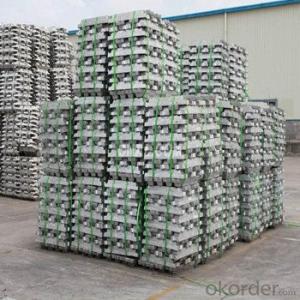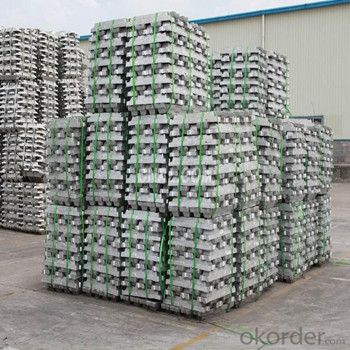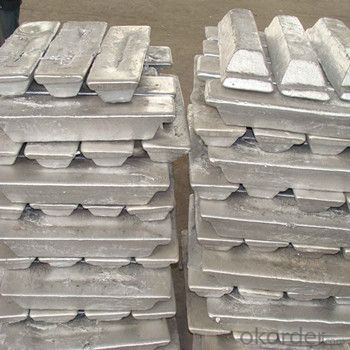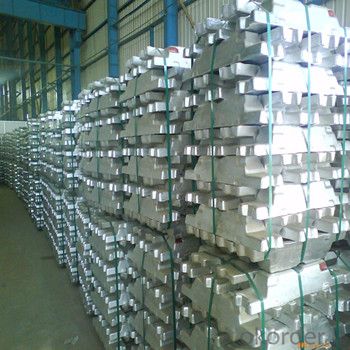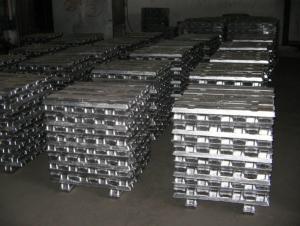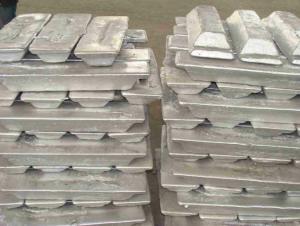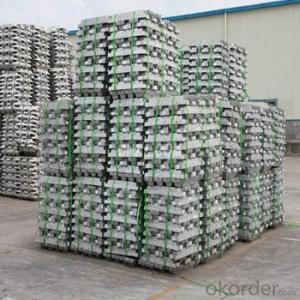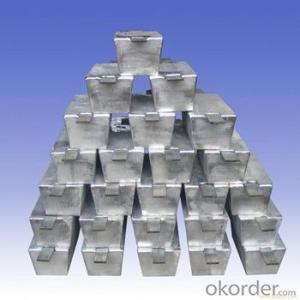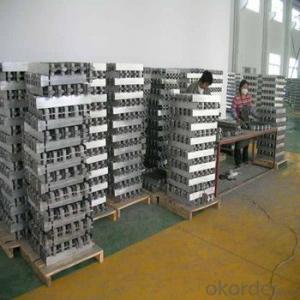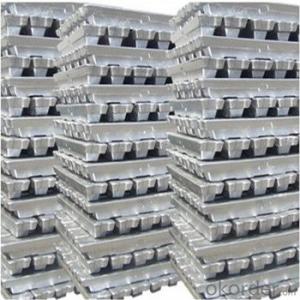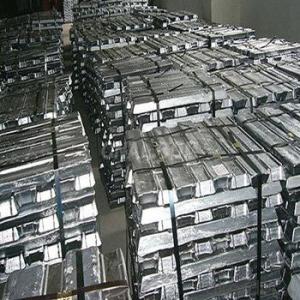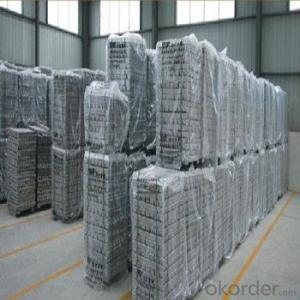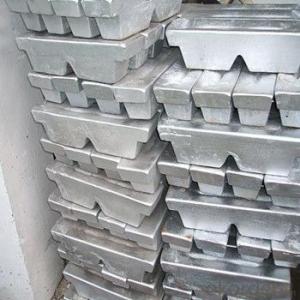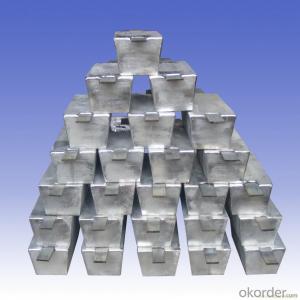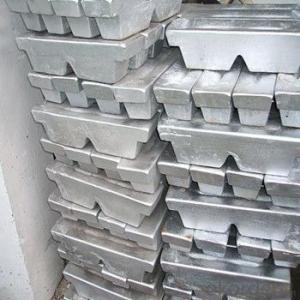Aluminium Ingot with 99.7% Purity and Wholesale from Mill
- Loading Port:
- China main port
- Payment Terms:
- TT OR LC
- Min Order Qty:
- 1000 m.t.
- Supply Capability:
- 10000 m.t./month
OKorder Service Pledge
OKorder Financial Service
You Might Also Like
Pure Aluminum Ingot Used for Industry
1.Structure of Aluminum Ingot Description
Aluminum Ingot is with the AL as the main chemical composition. Aluminum Ingot is used for industry,such as automobile,pinning and weaving,electron broadly and so on. Aluminum Ingot has the following advantages: easy control and operation, fast melting.
2.Main Features of the Aluminum Ingot
•High Purity
•Easy control and operation
•High strength
•Fast melting
•Competitive price
•Best Service
3. Aluminum Ingot Images
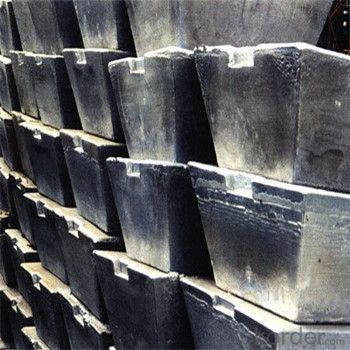
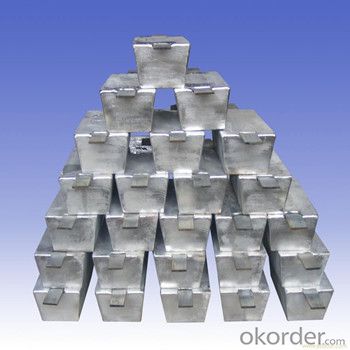
4. Aluminum Ingot Specification
Grade | Chemical Composition % | |||||||||
Al≥ | impurities ≤ | |||||||||
Si | Fe | Cu | Ga | Mg | Zn | Mn | others | Sum | ||
Al99.9 | 99.90 | 0.50 | 0.07 | 0.005 | 0.02 | 0.01 | 0.025 | - | 0.010 | 0.10 |
Al99.85 | 99.85 | 0.80 | 0.12 | 0.005 | 0.03 | 0.02 | 0.030 | - | 0.015 | 0.15 |
Al99.7 | 99.70 | 0.10 | 0.20 | 0.010 | 0.03 | 0.02 | 0.030 | - | 0.030 | 0.30 |
Al99.6 | 99.60 | 0.16 | 0.25 | 0.010 | 0.03 | 0.03 | 0.030 | - | 0.030 | 0.40 |
Al99.5 | 99.50 | 0.22 | 0.30 | 0.020 | 0.03 | 0.05 | 0.050 | - | 0.030 | 0.50 |
Al99.00 | 99.00 | 0.42 | 0.50 | 0.020 | 0.03 | 0.05 | 0.050 | - | 0.050 | 1.00 |
5.FAQ of Aluminum Ingot
We have organized several common questions for our clients,may help you sincerely:
①How about your company?
A world class manufacturer & supplier of castings forging in carbon steel and alloy steel,is one of the large-scale professional investment casting production bases in China,consisting of both casting foundry forging and machining factory. Annually more than 8000 tons Precision casting and forging parts are exported to markets in Europe,America and Japan. OEM casting and forging service available according to customer’s requirements.
②How to guarantee the quality of the products?
We have established the international advanced quality management system,every link from raw material to final product we have strict quality test;We resolutely put an end to unqualified products flowing into the market. At the same time, we will provide necessary follow-up service assurance.
③How long can we receive the product after purchase?
In the purchase of product within three working days, We will arrange the factory delivery as soon as possible. The pecific time of receiving is related to the state and position of customers.Commonly 7 to 10 working days can be served.
- Q: How are aluminum ingots used in the production of signage?
- Aluminum ingots play a crucial role in the production of signage due to their lightweight, durability, and versatility. When producing signage, aluminum ingots are melted down and then transformed into various sign components or sheets, depending on the desired design and purpose. One of the main uses of aluminum ingots in signage production is for creating sign frames. These frames provide structural support and stability to the signage, ensuring its longevity and resistance to weather conditions. The lightweight nature of aluminum makes it easier to transport, install, and maintain these sign frames. Additionally, aluminum ingots are often used to create sign panels or sheets. These panels can be cut, drilled, or shaped into various sizes and designs, allowing for customization and creativity in signage production. The durability of aluminum ensures that these panels can withstand outdoor exposure and remain intact for extended periods. Moreover, aluminum ingots are used to produce sign letters or logos. Signage made from aluminum letters provides a professional and sleek appearance that can enhance the overall aesthetic appeal of the signage. By using aluminum ingots, sign manufacturers can create precise and intricate lettering with ease. Furthermore, aluminum ingots offer excellent corrosion resistance, making them suitable for outdoor signage applications. They can withstand harsh weather conditions, UV exposure, and temperature variations without deteriorating or losing their visual appeal. This makes aluminum an ideal material for outdoor signs where durability and longevity are essential. In summary, aluminum ingots are widely used in the production of signage due to their lightweight, durability, and versatility. They are transformed into sign frames, panels, and letters, providing structural support, customization options, and a professional appearance. With their corrosion resistance, aluminum ingots ensure that signage remains intact and visually appealing even in challenging outdoor environments.
- Q: What is the role of aluminum ingots in the production of aircraft engines?
- Aluminum ingots play a crucial role in the production of aircraft engines as they are used to manufacture various engine components. Aluminum, being lightweight and possessing excellent thermal conductivity and corrosion resistance, is an ideal material for aircraft engines. The ingots are melted and cast into different shapes to create parts such as engine casings, pistons, cylinder heads, and other structural components. These ingots provide strength and durability while helping to reduce the overall weight of the engine, resulting in improved fuel efficiency and performance of the aircraft.
- Q: What is the difference between remelting aluminium ingot and alloy aluminium ingot?
- General remelting aluminum ingot is a waste aluminum melting by boiler, is a small factory recycling processing! The standard alloy aluminium ingot is made of A00 aluminum according to the requirement and various metal proportion
- Q: Production process of aluminium ingot
- In the world has proven reserves of bauxite, 92% is weathering lateritic bauxite, belonging to gibbsite type bauxite. The characteristics of these is low silicon, high iron and high silicon aluminum ratio, concentrated in West Africa, Oceania and central and South america. The remaining 8% are sedimentary type bauxite, belong to diaspore and diaspore type, low grade, mainly in Greece, the former Yugoslavia and Hungary and other places.
- Q: Can aluminum ingots be used in 3D printing?
- Indeed, aluminum ingots have the ability to be utilized in the realm of 3D printing. The reason behind this lies in the fact that aluminum possesses attributes such as being lightweight, possessing high strength, and exhibiting exceptional thermal conductivity. Nevertheless, instead of employing aluminum ingots directly, a technique known as powder bed fusion comes into play. More specifically, one can utilize selective laser melting (SLM) or electron beam melting (EBM) within this process. The modus operandi is as follows: fine aluminum powder is evenly distributed in thin layers, subsequently being selectively melted through the application of a laser or electron beam, layer by layer, in order to achieve the desired 3D object. This method enables the production of intricate geometries and exact parts, all while maintaining an elevated level of strength and precision.
- Q: What are the safety precautions when handling aluminum ingots?
- Some safety precautions when handling aluminum ingots include wearing appropriate personal protective equipment such as gloves, safety glasses, and a face shield to protect against potential hazards. It is also important to handle the ingots with care to prevent injury from sharp edges or falling objects. In addition, proper lifting techniques should be used to avoid strain or back injuries. Fire safety measures should be implemented, as aluminum can react with water or air at high temperatures. Overall, following proper handling procedures and being aware of potential risks can help ensure the safety of individuals working with aluminum ingots.
- Q: How are aluminum ingots used in the production of window frames?
- Aluminum ingots are melted down and formed into extruded profiles, which are then cut and assembled to create window frames. The ingots provide the raw material necessary for the manufacturing process and ensure the frames are lightweight, durable, and corrosion-resistant.
- Q: Can aluminum ingots be anodized?
- Aluminum ingots are capable of undergoing anodization. Anodization, an electrochemical procedure, yields a safeguarding oxide layer on the exterior of aluminum. This technique can be employed on aluminum ingots, sheets, or any other manifestations. Anodization boasts numerous advantages, including heightened resistance against corrosion, enhanced durability, and the potential to introduce color onto the surface. Moreover, the anodized layer enriches the aesthetic appeal of the aluminum and facilitates superior adhesion of paints or dyes. In summary, the anodization of aluminum ingots is a prevalent practice across diverse industries to augment both the properties and appearance of the metal.
- Q: How are aluminum ingots used in the production of solar panels?
- Aluminum ingots are used in the production of solar panels primarily for their lightweight, corrosion-resistant, and thermal conductivity properties. They are typically used to manufacture the frames and mounting structures of solar panels, providing structural support, durability, and stability. The aluminum frames also play a crucial role in protecting the solar cells and other components from external environmental factors. Moreover, the excellent thermal conductivity of aluminum helps in dissipating heat generated by the solar cells, ensuring efficient operation and longevity of the panels.
- Q: How can the energy efficiency of aluminum ingot production be improved?
- There are multiple approaches to enhancing the energy efficiency of aluminum ingot production. To start, the implementation of cutting-edge technologies and equipment can yield substantial reductions in energy consumption during the production process. For instance, the utilization of energy-efficient furnaces and heat recovery systems enables the capture and reuse of wasted heat, thereby decreasing the overall energy requirement. Furthermore, optimizing the production process can result in improved energy efficiency. This can involve measures such as minimizing the number of steps, streamlining workflow, and minimizing material losses. By identifying and eliminating any bottlenecks or inefficiencies in the production line, energy consumption can be diminished. In addition, embracing sustainable practices can contribute to energy efficiency. This can entail harnessing renewable sources of energy, like solar or wind power, to generate electricity for the production process. Moreover, implementing energy management systems and conducting regular energy audits can assist in identifying areas where energy consumption can be further reduced. Additionally, recycling and reusing aluminum scrap is a highly effective method of enhancing energy efficiency. By establishing a closed-loop system, where scrap aluminum is collected, melted, and reintroduced into the production process, the energy-intensive extraction and refining processes can be minimized. Lastly, raising employee awareness and fostering engagement can play a pivotal role in improving energy efficiency. Educating the workforce about the significance of energy conservation and providing training on energy-saving practices can cultivate a more energy-conscious work environment. In conclusion, a combination of advanced technologies, process optimization, sustainable practices, recycling, and employee engagement can significantly boost the energy efficiency of aluminum ingot production. By implementing these measures, the industry can reduce energy consumption, lower greenhouse gas emissions, and strive towards a more sustainable future.
Send your message to us
Aluminium Ingot with 99.7% Purity and Wholesale from Mill
- Loading Port:
- China main port
- Payment Terms:
- TT OR LC
- Min Order Qty:
- 1000 m.t.
- Supply Capability:
- 10000 m.t./month
OKorder Service Pledge
OKorder Financial Service
Similar products
Hot products
Hot Searches
Related keywords
